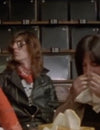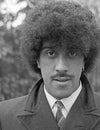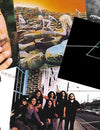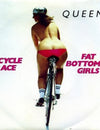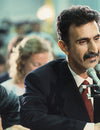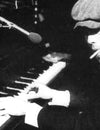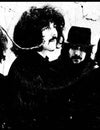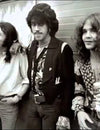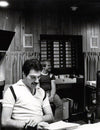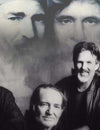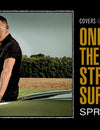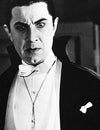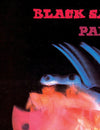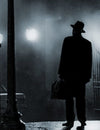
Why The Exorcist Still Scares Like No Other
No possession film will ever be as frightening as The Exorcist(1973) because it is a movie no one wants to make anymore. Filmmakers repeatedly try to copy it, but that’s not the same as producing a bold and groundbreaking original work, and when they do, they try to speed up the action to get to the thrills. The devil likes it slow and has never been more intimate, and real as in director William Friedkin's multi-Oscar-nominated film. It is scary because it is studiously subdued, and daringly sloppy.
The Exorcist terrified moviegoers when it came out a day after Christmas in ‘73. William Peter Blatty’s novel was a bestseller before that, threatening to infest every bookshelf in every home in America. It was a demon just waiting for some studio to unleash it into theaters, and Warner Bros. heralded its unholy unveiling.
Word on the street warned that viewers ran out of auditoriums and passed out in the lobbies at the phantasmagorical extravaganza. Nearsighted audience members removed contact lenses to be spared the promised splatter spectacle of projectile pea soup vomiting, ghastly head-spinning, and unimaginably excruciating crucifix insertions. Reverend Billy Graham denounced the motion picture, saying, “The Devil is in every frame of this film,” as if that would make it any less appealingly frightening.

The mythology preceded the film before its initial release, and its reputation has only made that legend grow. A millisecond of one image from the film has appeared in countless viral memes, and to this day it can scare a modern audience if they gather in a dark theater and turn off their phones. The reason the expectations of the mind-numbing terror are still met has little to do with the appalling and all-too-real appearing imagery, however. It is in the slow-motion delivery of characters we care about, deeply, who are faced with an existential crisis. Is it satanic? It doesn’t matter, but it is.
An Evil Universe That Feels Real
Regan McNeil, played by 13-year-old Linda Blair, is the main reason the cast is significant. She performs like a seasoned pro. Since the actor playing the character is not so far removed from the source or the memory of the most imaginative era, it feels very natural to watch. Every child engages in make-believe play at some point, but Blair gives herself over to the role more completely than even the possessed preteen on the page.
Blair makes Regan a fully realised, absolutely relatable, fearful child who the audience cares for long before the devil forces her to do anything. Is her mind messed up? we ask ourselves. We just want everyone to leave the boy alone, including the doctors and scientists who are prodding and probing him, the dinner guests who are gawking, and the cops who are questioning him. We're almost relieved when the priest is summoned in. But that's when things start to become really bad, which is why that scene is the scariest in the whole movie.
Before the dissonance of artificial horrors may register in the viewer's mind, they must first empathise with more real, yet still horrific, terrors. Chris MacNeil's (Ellen Burstyn) inability to help her daughter, Regan, infuriates us, and science's inability to provide answers breaks our hearts. The audience empathises with Father Damien Karras (Jason Miller), who must make a difficult choice in order to assume control of Regan. Famously, Johnny Friendly from On the Waterfront is just one example of Lee J. Cobb's penchant for writing boisterous, impetuous characters. In the 1951 film Sirocco, he terrified Humphrey Bogart, and in the 1976 film 12 Angry Men, he was so intimidating that he could have hung an entire jury (1957).
As Lt. William Kinderman in The Exorcist, Cobb delivers a performance of remarkable restraint, conveying all the anguish, frustration, and curiosity that the character feels about the mission and its participants.
Regan serves as the film's unifying force. Film stock and footage grade are now relics of the past, replaced by flawless visuals that are enhanced further by CGI, and imitations abound. These factors combine to make redos and second chances less likely. The film's lack of polish and grainy, documentary-like aesthetic are used to maximum effect in 1973. There was a greater commitment to realism in The Exorcist.
Real Time Horror
The narrative was, as incessantly promoted, based on real occurrences. Blatty intended to document an actual exorcism that had place at a St. Louis psychiatric clinic in 1949. He had heard accounts of telekinetic activity that stood out from others he had heard about. While they disregarded the possibility of possession, doctors put stock in the curative potential of suggestion. The Catholic Church approved, and Father William Bowdern officiated the wedding with the help of another priest, William Halloran.
Blatty dramatised the story because of the lack of clarity and the desire to conceal the identity of the real topic on the part of family members. Blatty rewrote The Exorcist to feature a female protagonist instead of the traumatised 13-year-old boy.
Before The Exorcist, neither Blatty nor Friedkin had directed a horror film. Blatty's normal fare was comedies, such as his script for Blake Edwards' 1964 Pink Panther feature, A Shot in the Dark. He left The Exorcist completely devoid of comedy on purpose, so that spectators would be subjected to nonstop tension and suffering with nowhere to turn.
When Friedkin directed The French Connection in 1971, he took home an Academy Award. The Exorcist has the same cinema verté realism as his other documentaries. The atmosphere is real, the pace is slow, and the characters are all given plenty of attention. The audience buys into the supernatural jumps because they feel natural, like they are a part of the actual collected footage. What occurs to Regan is not unique to her or her household.
Extreme violence is not gratuitous and serves to further the plot. A trip to the emergency room would not have been necessary if Regan hadn't urinated on the floor during a formal dinner. Regan's mother calls a priest because of the crucifix incident. This is happening right now to her daughter, and it is not something that can be treated with medication or psychiatry.
Blair, a complete unknown at the time, was hired so she and the director could have an in-depth conversation about the crucifix scene. Blair was the only one of the applicants who, in Friedkin's opinion, could handle the part and the harsh words without being injured. As for the masturbatory crucifix scene, it was filmed with a stand-in named Eileen Dietz and was shot from the back.
Special Effects that Stand the Test of Time
The now-iconic makeup effects in The Exorcist were largely due to the work of Dick Smith. Smith, with the help of effects experts Ron Nagle, Doc Siegel, Gonzalo Gavira, and Bob Fine, transformed a realistic, innocent preteen into a nasty vessel for the demon Pazuzu. He looked up pictures of gangrenous wounds and burned victims online to get the right shading for the possessed kid's wounds.
Swedish actor Max von Sydow, who was 43 at the time of filming, became an exact likeness of Father Bowdern, the priest who performed the 1949 exorcism, in order to produce the old visage of Father Lancaster Merrin.
The make-up trials were utilised as well. It's possible that the smiling unused footage of Blair in test makeup was the source of the subliminal image Billy Graham claimed to be a true demonic image. Another occult indication was right under the preacher's nose, but he didn't see it. Subliminal audio and visuals were placed under frames by Friedkin to unnerve viewers, although not as much as was initially thought. He incorporated the buzzing of bees, a sound long associated with danger, and added the rumbling of distant factory machinery to make the listeners feel threatened.
When Father Karras dreams about his mother—long dead but nonetheless a source of sadness and guilt—a white face briefly appears. Smith's original suggestion for demonic makeup, applied on Blair's stand-in, Dietz, appears briefly in the film. At the 45-minute mark, there's a brief but noticeable moment that lasts only a fraction of a second. After the credits rolled in 1973, many questioned whether or not they had actually seen the film.
Mercedes McCambridge, winner of an Oscar, provided the voice of the evil Pazuzu. Flangers, echoes, fuzz boxes, and multitracking were unnecessary for her. McCambridge began eating raw eggs again, and he resumed his cigarette and alcohol use. The realistic wheezing croak she made to imitate Pazuzu coming out of a little girl cost her dearly in AA. McCambridge had her sponsor, a minister, accompany her to all of her filming commitments. Not that a little sprinkle of holy water wouldn't do any good on set.
Tales of a Cursed Set
Some of the film's subliminal sedition comes from the production environment even when it's not on screen. The Exorcist has more impact than other possession movies because of the legends surrounding its supposedly cursed set. Jason Miller's son was hit by a man on a motorcycle and nearly killed during production; Jason von Sydow's brother died on the first day of shooting; Burstyn was dragged so hard by a harness pulled by the director that she suffered a spine injury; she had to use crutches for most of the filming.
Another tragic example from Hollywood lore is the death of Jack MacGowran, who had just finished filming his role as drunken director Burke Dennings, just before the picture was released. But in 1979, Paul Bateson, who played the radiologist in the cerebral angiography sequence, was convicted of murdering entertainment journalist Addison Verril.
Overnight, the set of the MacNeil household, which was being filmed on a decommissioned New York staging, was destroyed by fire. The fire's cause was never determined, but manufacturing was halted for two months. There are urban legends circulating about the cursed and haunted Washington D.C. staircase where the priest is tossed in one of the film's numerous climactic scenes.
Many people believe that the release of The Exorcist II: The Heretic in 1977 marked the beginning of the end for the film's ability to captivate audiences in the same way that the original did in 1973. Audiences were sent to sleep just like Linda Blair's character, a now-adolescent and terrified version of herself seen above wearing strobe-lit headgear. In spite of this, I found myself enjoying the film, even though it fell short of the original. Surviving the curse was easier for later entries.
One of the best possession movies done following Blatty's 1973 original is The Exorcist III (1990), directed by Blatty and starring George C. Scott and Brad Douriff. It's a continuation of the Exorcist series, but it's also an improvement. It has the same level of suspense as the first picture but is less accessible to the audience. Renny Harlin's Exorcist: The Beginning (2004) (after the studio dropped Paul Schrader's take on the subject) is an adequate standalone film about broken faith, Nazi occultism, and unsuccessful exorcisms, but its real purpose was to draw crowds and make money.
At least in 2005, the company produced Dominion, Schrader's Exorcist prequel, and the film is a worthy possession film, full of fear and spirituality in equal measure. In the film, good is shown to be rather ineffective, and the devil is accepted. Every single instalment is both terrifying and thought-provoking from a religious standpoint. The audience's mind and the concepts presented to them are where the real challenge lies. None, however, achieved classic status.
In 2017, Friedkin went back to the well and directed The Devil and Father Amorth, a documentary about an Italian woman who, after eight previous priests failed, is ready to endure her ninth exorcism. He breaks whatever hope that the voyage might have been heading to by leaving his camera in the car during the final, most dramatic, and successful ceremony, which he relates in audio. It's a passable paranormal documentary that captures some interesting details about exorcisms but doesn't shed much light on the subject.
Exorcism To The Max
Some movies have come close to channelling the gloominess of the original "devil-made-me-do-it" film, but none have quite succeeded. When others have succeeded, most have deviated from the norm.
The Exorcism of Emily Rose (2005), based closely on the documented case of Anneliese Michel, hurries a little too rapidly over the backstory of the 21-year-old German woman who was de-possessed to death to inspire the same empathy the audience feels for Regan. This is the biggest problem with an otherwise refreshing take on possession. Director Scott Derrickson presents it in a novel courtroom drama format, with Tom Wilkinson as the priest whose sacrificial rites went horrifically awry and Laura Linney as his lawyer.
There's a palpable sense of unease throughout the picture, and it's never made clear whether or not Emily (Jennifer Carpenter(un)diagnosed )'s temporal lobe epilepsy was the cause of her occurrences. Anneliese Michel (portrayed by Emily in the movie) had 67 exorcisms between 1975 and 1976. After further investigation, German bishops rescinded the possession label and concluded that the woman had starved to death as a result of the exorcism rituals. The mother, as well as the two priests who performed the rites, were found guilty of negligent homicide. Adding more realism and slowing down the pace would have made this film far more terrifying and memorable, on par with The Exorcist.
The protagonists of two of the most chilling and suspenseful possession movies are not a troubled kid, but rather two jaded police officers, one from a city homicide squad and the other in private practise. Azazel is the main devil in the 1998 film Fallen. This demon may possess humans through touch, hopping from body to body like a tired scapegoat in need of atonement. This is how it avoids its death sentence and goes on an awful killing spree. Denzel Washington plays as John Hobbes, who almost succumbs to the Old Testament creature and lets it possess him in this action thriller.
In the 1987 film Angel Heart, Mickey Rourke plays private eye Harry Angel, who turns out to be the soul of jazz singer Johnny Favorite, who sold his soul to the devil for fame, fortune, and powers so dark that the local voodoo priestess concludes, "Favorite was as close to true evil as she ever wanted to come."
Louis Cyphre, the devil himself, played by Robert De Niro, hints at the possibility of possession when it is revealed that Angel has been committing crimes to cover up his prior identity. If you ask Cyphre, "guided by my own hand, of course" is how Angel went on his rampage. Is it possible that Angel was possessed by Lucifer to perform the coverup crimes and implicate himself, or that he committed them as an emerging Favorite and gave his memories to the soul who genuinely possesses his identity? Possession is more of a concern now than it ever has been.
Science and Religion
John Carpenter's Prince of Darkness (1987) takes a clinical look at possession. A professor (Victor Wong) and a priest (Donald Pleasence) lead a team of scientists and students as they investigate a jar from a church basement containing a substance that may be the Devil's corporeal manifestation according to an ancient text but is disproved by laboratory tests. Dark and brooding, it all washes away before the end of days. The movie would tank before a jury of its peers.
Exorcism tales predate the canonical Roman Ritual of 1614, as do accounts of demonic possession. Demons are actual, physical entities, according to the Bible. Jesus drove out demons and told his followers to do the same. According to 1 Peter 5:8, Satan "prowls around like a roaring lion, seeking someone to devour." This verse continues to be a source of faith for Christians even today. A personal creature who assaults us, not a story, metaphor, symbol, figure of speech, or idea, is how Pope Francis put it as late as 2018.
There have been hardly any confirmed incidents of actual possession. Practically every case of alleged possession has been revealed to be an instance of mental illness. The Holy Roman Church deemed the original case on which The Exorcist was based to be a psychiatric one.
From The Amityville Horror in 1979 to James Wan's reclaiming of the possession genre in films like Insidious (2010) and The Conjuring (2013), films based on the actions of demonologists Ed and Lorraine Warren provide a unique set of challenges for this reason (2013).
The Warrens were able to spot the devil wherever but in themselves. They were shown on TV and possibly got better tables at restaurants as a result. You can almost see them hanging over a family's meal and describing the tortures planned by a serial killer who is still at large and in possession of the person who made this placemat. Please vacate the seat. Even when he's at the dinner table, the Exorcist takes the most prominent spot.
Holy Jebus
Jewish mythology provides the primary source of intrigue for Ole Bornedal and Jeffrey Dean Morgan's The Possession (2012). Malicious occupying spirit the dybbuk has its roots not in canonical Hebrew writings but in folklore from the 1600s that was later adapted into a play by Shloyme Zanvl Rappoport in 1914.
The Shining (the Stanley Kubrick film), The Shining (the Stephen King novel), and "The Shinning," a clip from The Simpsons' "Treehouse of Horror V," are among the most cunning pieces of fiction since they do not involve demonic possession. Jack Nicholson's character, the Overlook's caretaker Jack Torrance, is clearly influenced by a malevolent force, whether it is the hotel's spirits or something more sinister.
In Sinister (2012), directed by Scott Derrickson, Ethan Hawke plays a true crime writer who comes upon an 8mm snuff tape that appears to capture a possessed child murdering a family. It grows into a household danger, yet it stays alive long enough for viewers to get to know the rascals before they are driven out of their homes.
The Exorcist succeeds thanks to its low-profile cast, tight focus, little budget, and sluggish pace, even during the film's most frenetic chase scenes. In today's most popular possession movies, the expensive special effects and number of jump scares are given top billing.
The handmade quality of The Exorcist is a key to its success. The only way to find out if the devil used those hands for his own purposes is to consult the Ouija board. If it happened, Max von Sydow's character, Father Merrin, would always have an exorcism kit with him in his suitcase. Regan's diabolical smile, whether glimpsed for an instant just out of view or laying its sights on us from her endlessly twisting head, has left an indelible mark on the imaginations of horror lovers. Because of this, no future possession film will ever be as terrifying as The Exorcist. Those visuals will remain seared into our souls forever.




















